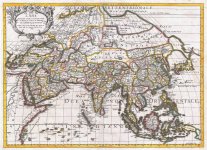The Kingdom
The Kingdom of Ormus (also known as Ohrmuzd, Hormuz, and Ohrmazd; Portuguese: Ormuz) was a 10th- to 17th-century kingdom located within the Persian Gulf and extending as far as the Strait of Hormuz. The Kingdom was established by Arab princes in the 10th century who in 1262 came under the suzerainty of Persia, before becoming a client state of the Portuguese Empire.- The kingdom received its name from the fortified port city which served as its capital. It was one of the most important ports in the Middle East at the time as it controlled seaway trading routes through the Persian Gulf to India and East Africa. This port was located on Hormuz Island, which is located near the modern city of Bandar-e Abbas.
- The Strait of Hormuz is a narrow, strategically important waterway between the Gulf of Oman in the southeast and the Persian Gulf in the southwest. On the north coast is Iran and on the south coast is the United Arab Emirates and Musandam, an exclave of Oman.
- Ormus - Wikipedia
The Island
Hormuz Island, also spelled Hormoz, is an Iranian island in the Persian Gulf. Located in the Strait of Hormuz, 8 kilometres (5 mi) off the Iranian coast, the island is part of Hormozgan Province.- Hormuz Island - Wikipedia
- Hormoz Island
- Did this island get nuked, or what?
KD: Do I have the wrong island for 2019, or something happened back in the day to alter its shape and form? Also, does it look like the 1756 version of the island is... incomplete, as in missing two huge chunks of the island?
Check out the Star-Fort: Fortified city at Hormuz, Persia, Iran, 17th century. Illustration by Johan Albrecht de Mandelslo (1616–1644). Seventeenth-century German adventurer, who wrote about his travels through Persia and India.- I wish I could draw like that...
Portuguese household in Hormuz
What about the size difference between these individuals?
Houses were purposely flooded because of the heat. Depicted in the Códice Casanatense.
- First of all, how did they flood them? Dug a trench, or carried water in a bucket?
- And then we have this wonderful sauna effect this would have caused... I guess "hormozians" preferred it extra-muggy...
Some Pics
There are some interesting pictures in the Google Maps.


